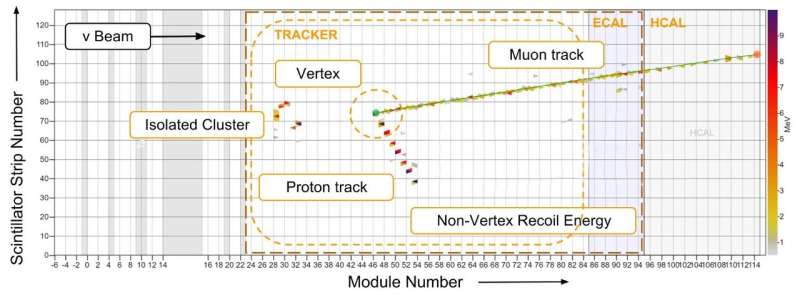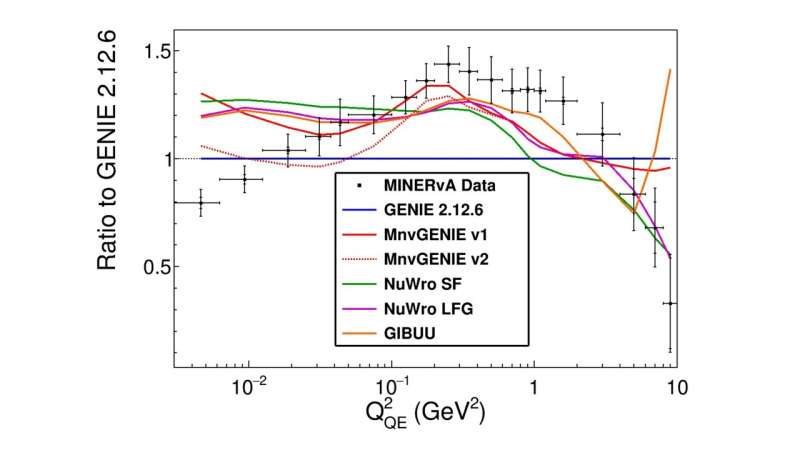Playing pool with neutrinos: Certain interactions look similar to the game

Hard to believe you can play pool with neutrinos, but certain neutrino interaction events are closer to the game than you think.
In these charged-current quasielastic interactions—CCQE interactions, for short—a neutrino strikes a particle in an atom's nucleus—a proton or a neutron. Two particles emerge from the collision. One is a muon, a heavier cousin of the electron. The other is either a proton (if the stationary particle is a neutron) or a neutron (if the stationary particle is a proton).
The neutrino interactions that result from these quasielastic reactions are like the collisions between balls in a game of pool: You can guess the energy of the incoming neutrino by measuring the direction and energy of only one of the outgoing particles, provided you know the types of all four particles that were in the interaction in the first place and the original direction of the neutrino.
CCQE interactions are an important interaction mode of neutrinos in current and future neutrino oscillation experiments, such as the international Deep Underground Neutrino Experiment, hosted by Fermilab.
They are similar to the elastic interactions every pool player knows except in one important way: The weak nuclear force allows the particles to change from one kind into another, hence the "quasielastic" name. In this subatomic pool game, the cue ball (neutrino) strikes a stationary red ball (proton), which emerges from the collision as an orange ball (neutron).
Since most modern neutrino experiments use targets made of heavy nuclei ranging from carbon to argon, nuclear effects and correlations between the neutrons and protons inside the nucleus can cause significant changes in the observed interaction rates and modifications to the estimated neutrino energy.

At MINERvA, scientists identify the CCQE interactions by a long muon track left in the particle detector and potentially one or more proton tracks. However, this experimental signature can sometimes be produced by non-CCQE interactions due to nuclear effects inside the target nucleus. Similarly, nuclear effects can also modify the final-state particles to make a CCQE event look like a non-CCQE event and vice versa.
Since nuclear effects can make it challenging to identify a true CCQE event, MINERvA reports measurements based on the properties of the final-state particles only and calls them CCQE-like events (since they will have contributions from both true CCQE and non-CCQE events). A CCQE-like event is one that has at least one outgoing muon, any number of protons or neutrons, and no mesons as final-state particles. (Mesons, like protons and neutrons, are made of quarks. Protons and neutrons have three quarks; mesons have two.)
MINERvA has measured the likelihood of CCQE-like neutrino interactions using Fermilab's medium-energy neutrino beam, with the neutrino flux peaking at 6 GeV. Compared to MINERvA's earlier measurements, which were conducted with a low-energy beam (3 GeV peak neutrino flux), this measurement has the advantage of a broader energy reach and much larger statistics: 1,318,540 CCQE-like events compared to 109,275 events in earlier low-energy runs.
MINERvA made these CCQE interaction probability measurements as a function of the square of the momentum transferred by the neutrino to the nucleus, which scientists denote as Q2. The plot shows discrepancies between the data and most predictions in low-Q2 and high-Q2 regions. By comparing MINERvA's measurement with various models, scientists can refine them and better explain the physics inside the nuclear environment.
MINERvA has also made more detailed measurements of the probability of neutrino interaction based on the outgoing muon's momentum. They take into account the muon's momentum both in the direction of the incoming neutrino's trajectory and in the direction perpendicular to its trajectory. This work helps current and future neutrino experiments understand their own data over a wide range of muon kinematics.
Mateus Carneiro, formerly of the Brazilian Center for Research in Physics and Oregon State University and now at Brookhaven National Laboratory, and Dan Ruterbories of the University of Rochester were the main drivers of this analysis. The results were published in Physical Review Letters.
More information: M. F. Carneiro et al. High-Statistics Measurement of Neutrino Quasielasticlike Scattering at 6 GeV on a Hydrocarbon Target, Physical Review Letters (2020). DOI: 10.1103/PhysRevLett.124.121801
Journal information: Physical Review Letters
Provided by Fermi National Accelerator Laboratory




















